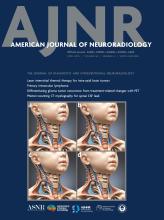This article requires a subscription to view the full text. If you have a subscription you may use the login form below to view the article. Access to this article can also be purchased.
Graphical Abstract
Abstract
BACKGOUND AND PURPOSE: This study utilizes a physics-based approach to synthesize realistic MR artifacts and train a deep learning generative adversarial network (GAN) for use in artifact reduction on EPI, a crucial neuroimaging sequence with high acceleration that is notoriously susceptible to artifacts.
MATERIALS AND METHODS: A total of 4,573 anatomical MR sequences from 1,392 patients undergoing clinically indicated MRI of the brain were used to create a synthetic data set using physics-based, simulated artifacts commonly found in EPI. By using multiple MRI contrasts, we hypothesized the GAN would learn to correct common artifacts while preserving the inherent contrast information, even for contrasts the network has not been trained on. A modified Pix2PixGAN architecture with an Attention-R2UNet generator was used for the model. Three training strategies were employed: (1) An “all-in-one” model trained on all the artifacts at once; (2) a set of “single models”, one for each artifact; and a (3) “stacked transfer learning” approach where a model is first trained on one artifact set, then this learning is transferred to a new model and the process is repeated for the next artifact set. Lastly, the “Stacked Transfer Learning” model was tested on ADC maps from single-shot diffusion MRI data in N = 49 patients diagnosed with recurrent glioblastoma to compare visual quality and lesion measurements between the natively acquired images and AI-corrected images.
RESULTS: The “stacked transfer learning” approach had superior artifact reduction performance compared to the other approaches as measured by Mean Squared Error (MSE = 0.0016), Structural Similarity Index (SSIM = 0.92), multiscale SSIM (MS-SSIM = 0.92), peak signal-to-noise ratio (PSNR = 28.10), and Hausdorff distance (HAUS = 4.08mm), suggesting that leveraging pre-trained knowledge and sequentially training on each artifact is the best approach this application. In recurrent glioblastoma, significantly higher visual quality was observed in model predicted images compared to native images, while quantitative measurements within the tumor regions remained consistent with non-corrected images.
CONCLUSIONS: The current study demonstrates the feasibility of using a physics-based method for synthesizing a large data set of images with realistic artifacts and the effectiveness of utilizing this synthetic data set in a “stacked transfer learning” approach to training a GAN for reduction of EPI-based artifacts.
ABBREVIATIONS:
- BTIP
- brain tumor imaging protocol
- GAN
- generative adversarial network
- HAUS
- Hausdorff distance
- MS-SSIM
- multiscale structural similarity index
- MSE
- mean square error
- NAWM
- Normal Appearing White Matter
- PSNR
- peak signal to noise ratio
- RANO
- Response Assessment in Neuro Oncology
- RAS
- Right, Anterior, Superior
- SSIM
- structural similarity index
- © 2025 by American Journal of Neuroradiology













